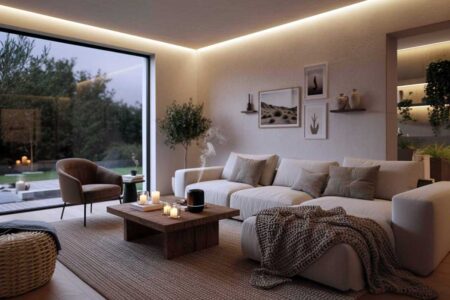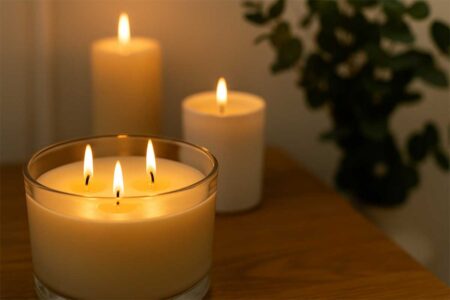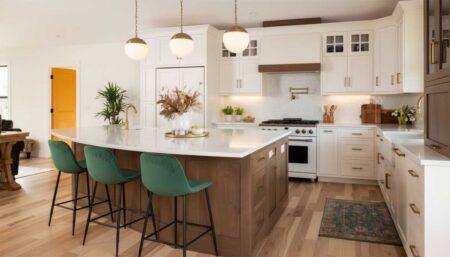Why YouTube is my favorite design school at home
If you want a better looking home without hiring a designer, YouTube is your best friend. About eight in ten U.S. adults use YouTube, so there is a channel for every style and budget. I learned more from creators in a few weekends than I did from months of scrolling mood boards.
What you will get here: my current list of interior design YouTubers that actually teach, plus quick steps to copy their wins at home. I included tiny mistakes I made so you can skip the headaches.
How to use this list, fast
- Pick three channels that match your space, small apartments, family homes, or full gut renos.
- Watch one room start to finish, then commit to one small change this week.
- Save videos to a private playlist, then turn on channel notifications so you do not miss the next part.
Quick checklist
- Decide your lane: renter, owner, or “someday soon”
- Choose one room
- Screenshot a color palette
- Measure twice, order once
- Try one change in 60 minutes, hardware swap, lamp, or rug size test
The 15 interior design YouTubers I actually watch
I organized these by the problem they solve, not by subscriber size. Use the “How to try it” steps right away.
1) Lone Fox: small spaces with big personality
Why it works: clear, step‑by‑step makeovers that feel doable.
How to try it:
- Pick one wall for impact.
- Add peel‑and‑stick texture, then hang one large art piece.
- Swap old knobs for matte black pulls.
Pro tip: Tape outlines on the wall before you buy shelves.
Common mistake: Going too small on rugs.
Budget: peel-and-stick paneling, about 30 to 60 USD.
Splurge: custom shelves, about 300 to 600 USD.
2) Mr. Kate: playful design that still functions
Why it works: fearless color plus renter-friendly hacks.
How to try it:
- Pick one accent color from a pillow you love.
- Repeat it in art, a throw, and a lamp.
- Use removable hooks for gallery walls.
Pro tip: Keep three finishes max, brass, black, wood.
Common mistake: Mixing too many metals.
Budget: removable hooks, about 10 to 20 USD.
Splurge: statement light fixture, about 200 to 450 USD.
3) Nick Lewis: calm, modern choices that age well
Why it works: explains why a choice works, not just what to buy.
How to try it:
- Choose a neutral main color.
- Add two accent colors only.
- Edit one item out of each surface.
Pro tip: Photograph your room, flaws pop on camera.
Common mistake: Buying decor before measuring.
Budget: cushion covers, about 15 to 30 USD.
Splurge: wool area rug, about 400 to 900 USD.
4) Kristen McGowan: budget upgrades that look high end
Why it works: room formulas you can copy.
How to try it:
- Upgrade lighting first.
- Center art at eye level, about 57 inches.
- Use symmetry where possible.
Pro tip: Spray primer on thrift finds before paint.
Common mistake: Hanging curtains too low.
Budget: curtain rods, about 20 to 35 USD.
Splurge: lined curtain panels, about 150 to 350 USD per pair.
5) The Sorry Girls: renter DIYs that pass the deposit test
Why it works: lots of reversible projects.
How to try it:
- Choose a reversible peel-and-stick for a test wall.
- Add under-cabinet lights with adhesive strips.
- Swap basic knobs for something fun.
Pro tip: Keep the landlord’s hardware in a labeled bag.
Common mistake: Forgetting to check paint rules.
Budget: battery puck lights, about 15 to 25 USD.
Splurge: plug-in sconces, about 120 to 250 USD each.
6) Kiva Brent, DIY with KB: design principles for beginners
Why it works: clear rules on scale, balance, and color.
How to try it:
- Decide your focal point first.
- Size the rug to the seating plan.
- Repeat textures three times.
Pro tip: Test fabric swatches in morning and evening light.
Common mistake: One tiny lamp lighting a whole room.
Budget: fabric swatch bundle, about 10 to 20 USD.
Splurge: quality sofa, about 900 to 1,800 USD.
7) XO, MaCenna: cozy vintage on a budget
Why it works: styling that looks collected, not random.
How to try it:
- Thrift one hero piece per room.
- Mix old wood with linen or velvet.
- Keep palette warm, then layer.
Pro tip: Bring a mini tape measure to thrift trips.
Common mistake: Over‑sanding vintage wood.
Budget: thrifted frames, about 5 to 15 USD.
Splurge: vintage dresser, about 250 to 600 USD.
8) House & Home: editor-level tours that teach layout
Why it works: shows professional floor plans and flow.
How to try it:
- Sketch your current layout.
- Move seating to face the focal point.
- Create clear walkways.
Pro tip: Float sofas off the wall a few inches.
Common mistake: Blocking natural light.
Budget: felt furniture pads, about 8 to 15 USD.
Splurge: custom built-ins, prices vary widely.
9) Studio McGee: clean, bright new-traditional
Why it works: balanced mix of classic and fresh.
How to try it:
- Choose light neutral walls.
- Add contrast with black or deep bronze accents.
- Use bigger art over many small pieces.
Pro tip: Ground airy rooms with a darker rug.
Common mistake: Too many small decor items.
Budget: oversized mat for art, about 25 to 40 USD.
Splurge: framed large-scale art, about 250 to 700 USD.
10) Architectural Digest, Open Door: celebrity homes, layout lessons
Why it works: great for proportion and scale ideas.
How to try it:
- Notice how big furniture actually is.
- Copy one smart storage idea.
- Borrow one color move, trim, door, or hardware.
Pro tip: Screenshot door trim profiles for your notes.
Common mistake: Buying undersized coffee tables.
Budget: cabinet hardware set, about 20 to 35 USD.
Splurge: custom millwork, pricing varies.
11) Apartment Therapy: small, lived-in spaces that work hard
Why it works: real homes with realistic constraints.
How to try it:
- Add vertical storage over doors.
- Use risers under beds.
- Mount a rail in the kitchen for tools.
Pro tip: Repeat one metal finish across a room.
Common mistake: Deep shelves in tiny rooms.
Budget: over-door shelf, about 30 to 50 USD.
Splurge: closet system, about 300 to 800 USD.
12) Never Too Small: micro apartments that feel intentional
Why it works: precise, space-saving detailing.
How to try it:
- Use sliding or pocket solutions where possible.
- Keep colors tight, then add one accent.
- Hide clutter behind flat fronts.
Pro tip: Use wall-to-wall curtains to fake architecture.
Common mistake: Deep sofas in small rooms.
Budget: slim wall shelves, about 25 to 60 USD.
Splurge: built-in banquette, about 600 to 1,200 USD.
13) The Kinwoven Home, Live Your Style: warm minimal for families
Why it works: practical, step-by-step family spaces.
How to try it:
- Zone living rooms with rugs.
- Choose washable fabrics.
- Add baskets by activity.
Pro tip: Keep a spare throw for toy cleanups before guests.
Common mistake: Silk rugs in play zones.
Budget: washable pillow covers, about 15 to 25 USD.
Splurge: performance sectional, about 1,200 to 2,500 USD.
14) Three Birds Renovations: bold color with structure
Why it works: clear planning, then big moves.
How to try it:
- Pick one bold color and one natural texture.
- Repeat them three times in the room.
- Keep floors simple so the color sings.
Pro tip: Sample paint on two walls, not one.
Common mistake: Matching whites without testing undertones.
Budget: paint samples, about 5 to 10 USD each.
Splurge: painter for a feature wall, about 200 to 400 USD.
15) The Local Project: architecture ideas you can scale down
Why it works: teaches proportion, materials, and calm palettes.
How to try it:
- Pick one hero material, wood, stone, or linen.
- Simplify lines on furniture.
- Use fewer, bigger pieces.
Pro tip: Hide cords with cable raceways.
Common mistake: Mixing too many wood tones.
Budget: cable raceway kit, about 15 to 30 USD.
Splurge: real wood dining table, about 700 to 1,500 USD.
Mini tool list for first projects
Under 50 dollars starter kit: tape measure, level, stud finder, picture hanging kit, command strips, painter’s tape. Start small, win fast.
Simple frameworks I learned the hard way
Lighting layers that make rooms look finished
Designers often talk about layers of light: ambient, task, and accent. Once I started setting up all three, my rooms finally looked intentional. Try this: one ceiling or large lamp for ambient, a reading lamp for task, and a small spotlight or plug-in sconce for accent.
Paint choices that do not knock you out
If you are painting, look at low or zero-VOC options and ventilate well. VOCs are gases from products like paint that can affect indoor air quality, so I keep windows open and take breaks. If you are sensitive, let a room cure for a couple of days before sleeping there.
One hour action plan
- Pick one YouTuber from this list and watch a single room makeover.
- Write three specific actions you can finish this week.
- Order one affordable item, bulb, rod, or hooks.
- Turn on channel notifications so you catch the next lesson.
Helpful internal reads to link: your small apartment decorating guide, renter-friendly upgrades, and paint ideas.
4) FAQ
Which interior design YouTubers are best for renters?
The Sorry Girls, Kristen McGowan, and XO, MaCenna share reversible projects and styling you can undo at move-out.
How do I know which channel fits my style?
Open three videos at once, then notice color, materials, and clutter levels. Save the one that feels calm to you.
Do I need fancy tools to start?
No. A tape measure, level, command strips, and a basic drill handle most beginner projects under 50 dollars.
Are these tips safe for kids and pets?
Choose low-VOC paint, add cord covers, and anchor tall furniture to studs. Ventilate during paint days.
How often should I update my watch list?
Quarterly works well. YouTube is widely used, and new creators pop up often, so refresh your list to learn new tricks.
Can I learn real design principles from YouTube?
Yes. Many creators teach scale, color, and layout. Pair videos with simple frameworks like lighting layers for faster wins.
5) Who, How, Why
Who wrote this: Blufashion Home & Decor editor, with help from our style contributors.
How we created it: We watched and tested projects from these channels in our own homes, then cross-checked best practices like lighting layers and safe painting with recognized authorities. Editors polished for clarity and U.S. readers.
Why we wrote it: You wanted interior design YouTubers that actually help you finish a room, not just pretty photos. This list trims the noise so you can act today.
6) Sources list with links and dates
- Pew Research Center, social media use in the U.S., YouTube used by 83 percent of adults, January 31, 2024.
- YouTube Help, how channel posts and notifications work, accessed July 28, 2025.
- American Lighting Association, lighting in layers fundamentals, accessed July 28, 2025.
- U.S. Environmental Protection Agency, VOCs and indoor air quality, accessed July 28, 2025.
More on Blufashion
- How to Invest in Real Estate During a Recession
- Average Property Prices in Downtown Dubai
- The Benefits Of Custom Kitchen Cabinets
- How Often Should You Have Your Home Electrical System Checked?
- Plug-in Wall Sconce Ideas For Renters






